

Projet BioCos / AMP Afrique de l’Ouest / Nos programmes / Accueil - Fondation Internationale du Banc d'Arguin. Protected Areas and Biodiversity. Why do we need biodiversity and protected areas?

Biodiversity - or biological diversity - is a term used to describe the variety of life on Earth. It refers to the number, variety and variability of living organisms (animals, plants, fungi, microbes, etc.), the genetic differences among them, and the ecosystems in which they occur. Disjunct distribution. In biology, a taxon with a disjunct distribution is one that has two or more groups that are related but widely separated from each other geographically.
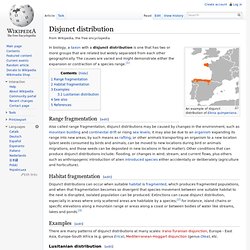
The causes are varied and might demonstrate either the expansion or contraction of a species range.[1] Range fragmentation[edit] Also called range fragmentation, disjunct distributions may be caused by changes in the environment, such as mountain building and continental drift or rising sea levels; it may also be due to an organism expanding its range into new areas, by such means as rafting, or other animals transporting an organism to a new location (plant seeds consumed by birds and animals, can be moved to new locations during bird or animals migrations, and those seeds can be deposited in new locations in fecal matter).
Biodiversity Informatics Facility - Species Distribution Modeling. About FishNet. The FishNet network is a collaborative effort among fish collections around the world to share and distribute data on specimen holdings.

There is an open invitation for any institution with a fish collection to join. The network was created in 1999 and initially relied upon a distributed query model based on the Z39.50 search/retrieval protocol. Over the years, FishNet has transitioned through a number of technological improvements. The modern search portal relies upon a core web service known as the Biological Object Search Service (BOSS) which is comprised of a series of software and database components that harvests data from providers, imports harvested data into a data cache and exposes the data cache via publicly accessible web based APIs. EMIBIOS - Chantier Manche Mer du Nord. End-to-end Modelling and Indicators for BIOdiversity Scenarios Avec une demande alimentaire croissante, l’exploitation des mers aura des impacts de plus en plus prononcés sur la biodiversité marine.
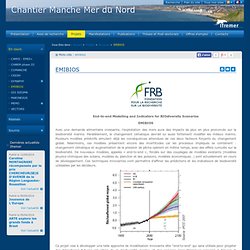
Parallèlement, le changement climatique devrait lui aussi fortement modifier les milieux marins. Plusieurs modèles prédictifs simulent déjà les conséquences attendues de ces deux facteurs forçants du changement global. Néanmoins, ces modèles présentent encore des incertitudes car les processus impliqués se combinent : changement climatique et augmentation de la pression de pêche opèrent en même temps, avec des effets cumulés sur la biodiversité. De nouveaux modèles, appelés « end-to-end », fondés sur des couplages de modèles existants (modèles physico-chimiques des océans, modèles du plancton et des poissons, modèles économiques…) sont actuellement en cours de développement. The Environmental Impact Assessment Toolkit - Process - Assessing Impacts on Coastal Areas. South Africa's diverse coastal and marine environments are a valuable resource, providing recreation and pleasure for residents and tourists alike.
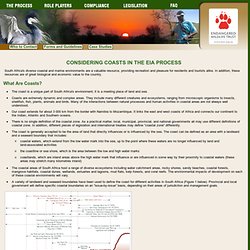
In addition, these resources are of great biological and economic value to the country. What Are Coasts? The coast is a unique part of South Africa's environment; it is a meeting place of land and sea. Tropical Coastal Ecosystem & Habitat Diagrams. In Coral Reef ecosystems, The detrimental effect of unregulated boating and diving activities should be taken into account.
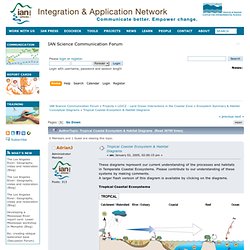
I understand that such a potential threat might not be considered as important or as priority interms of management as others (e.g global warming effects, sediment and nutrition runoffs, or overfishing). The Red Sea (case study), for instance, lacks freshwater runoffs, freshwater precipitation is minimal, and weather and sea conditions are optimal for coral reef growth. Coral bleaching has not been reported as a major threat in these region.
What seems to be the problem there is unregulated diving tourism. In the Northern Red Sea (Egypt, Jordan, and Israel) diving tourism in considered as the major driving force for the economies of these resorts. S National Ocean Service: Coastal Ecosystem Science. Within any given area, living and nonliving interact with each other.
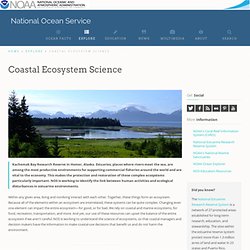
Together, these things form an ecosystem. Because all of the elements within an ecosystem are interrelated, these systems can be quite complex. Scientists - European Commission. Additional tools Oct 2011-present Stelios Katsanevakis (Ph.D.) is a marine ecologist specialized in benthic studies with a broad experience in field surveys, monitoring, and modelling.

His research focuses on population and community dynamics, biological invasions, marine conservation and management, biological monitoring. He has conducted many surveys investigating alien species occupancy, spatial distribution, impact, or invasion patterns in the Mediterranean. He now works in the Water Resources Unit of the Institute for Environment and Sustainability (JRC) on the assessment of current and future alien species distribution in Europe, and their impacts on ecosystem services and biodiversity. Listing the World's Algae. Marine Species Identification Portal.
Emma Marris: In Defense of Everglades Pythons. CES - Ecosystem Services Fact Sheets: Ecosystem Services. EEA - Thematic assessments. Species 2000 - Welcome to Species 2000 website. KU CORPI DATABASE SYSTEM - BINPAS. To login as demo used just press the button Login (username: demo, password: demo) This is a system to translate the existing data on miscellaneous invasive alien species impacts into uniform biopollution measurement units.
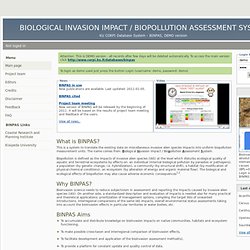
The name comes from: Biological Invasion Impact / Biopollution Assessment System. The invader’s double edge. The Ogasawara Archipelago (Bonin Islands,) encompasses several tens of small islands ~ 1000 km from mainland Japan.
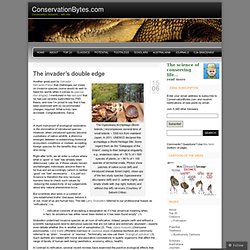
In 2011, UNESCO declared this archipelago a World Heritage Site. Some regard them as the “Galapagos of the Orient”, owing to their biological singularity, e.g., endemism rates of ~ 50 % of > 500 species of plants, or ~ 90 % of > 100 species of terrestrial snails. Photos show patches of native scrub (left) and introduced sheoak forest (right), close-ups of the two study species Ogasawarana discrepans (left) and O. optima (right), and empty shells with (top right, bottom) and without (top left) rat scars (Courtesy of Satoshi Chiba).
Another great post by Salvador Herrando-Pérez that challenges our views on invasive species (some would do well to heed his words when it comes to species like dingos). You're not from around here, or are you? › Opinion (ABC Science) In Depth › Analysis and Opinion Being able to tell natives from non-natives is critical, but we need to overhaul the way we go about doing this, cautions Melinda Trudgen and Bruce Webber. By Melinda Trudgen and Bruce Webber Earlier this year, a news story about how Aboriginals could have moved the iconic red cabbage palm to Central Australia between 15,000-30,000 years ago focused our sights on an important issue: how do we decide which plants and animals are native? What we found were outdated, conflicting and even racist definitions that aren't equipped to deal with how plants and animals move around, particularly in a world with a rapidly changing climate.
Using current definitions, the red cabbage palm in Central Australia can be classified as native or non-native depending on which definition you choose. Native invaders divide loyalties. California sea lion at Bonneville fish ladder. Credit: U.S. National Oceanic and Atmospheric Administration. Redmap Australia - Redmap. GEOG 030: Geographic Perspectives on Sustainability and Human-Environment Systems, 2011. Printer-friendly version “Extinction is the most irreversible and tragic of all environmental calamities. With each plant and animal species that disappears, a precious part of creation is callously erased.” -Michael Soulé, noted American conservation biologist It is estimated that the current rate of species extinction is between 1,000 and 100,000 times more rapid than the average rate during the last several billion years. The growth of human populations, consumption levels, and mobility is the root of most of the serious threats to biodiversity today.
While learning about the negative impacts of humans on biodiversity, please keep a few things in mind. There are many threats to biodiversity today. Habitat Loss: This occurs when a particular area is converted from usable to unusable habitat. Integrated Taxonomic Information System. BIOTIC. The Biological Traits Information Catalogue (BIOTIC) aims to provide scientists working within the field of benthic community ecology with an additional tool for their data analyses. Biological traits information of benthic species contained in the BIOTIC database can be downloaded and linked to benthic survey data. This may allow benthic data to be analysed not only on a taxonomic level but also on a functional level. The BIOTIC database contains information on over 40 biological trait categories on selected benthic species, together with additional supporting information, including a bibliography of literature from which the information was obtained.
The emphasis is on benthic invertebrates and plants. Users can browse the species list or search for information by specific categories of biological trait. We would like BIOTIC to be viewed as a first source of information on which scientists can draw when conducting a traits analysis on their specific benthic datasets. MarLIN, 2006. Tropical Signals Program. In Dead Water - Climate Change, Pollution, Over-harvest, and Invasive Species in the World's Fishing Grounds. Marine alien species. Invasive alien plant species potential distribution Alien plant species pose a major threat to South Africa’s native biodiversity.
It is estimated that more than 9 000 plant species have been introduced so far. Of these, about 198 species are deemed invasive, covering 10 per cent of the country. Since the invasive plants grow by an estimated 5 per cent a year, their presence has dramatic effects on both native species and ecosystems as well as economic activities in the area. In particular, alien ... Ocean Health Index.